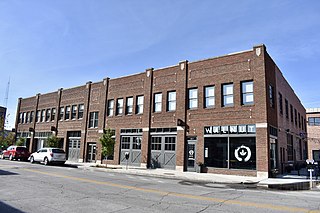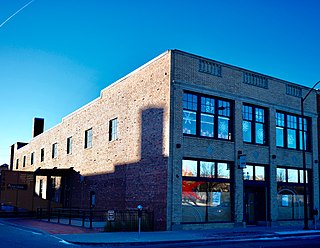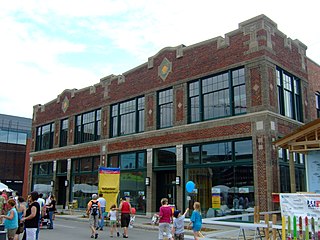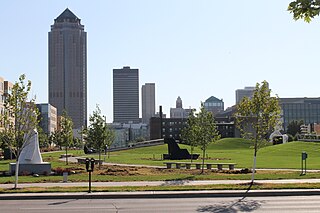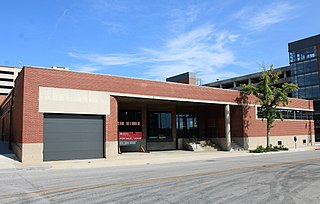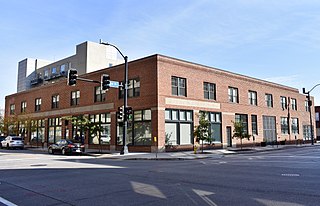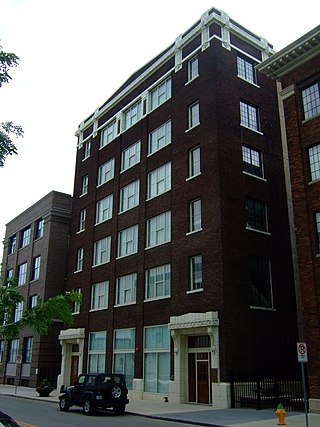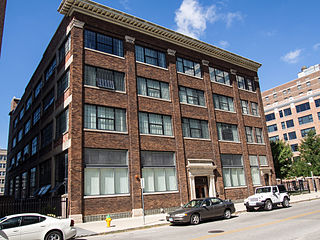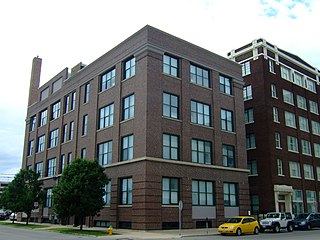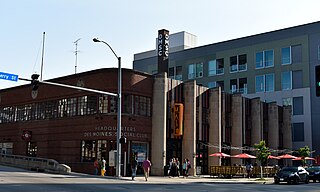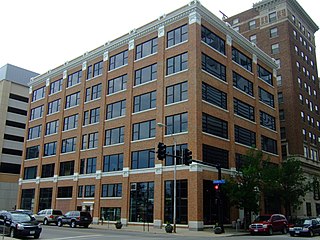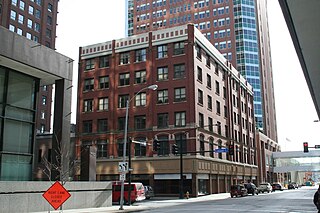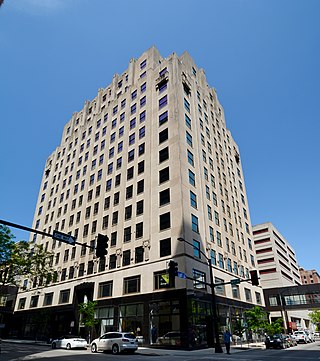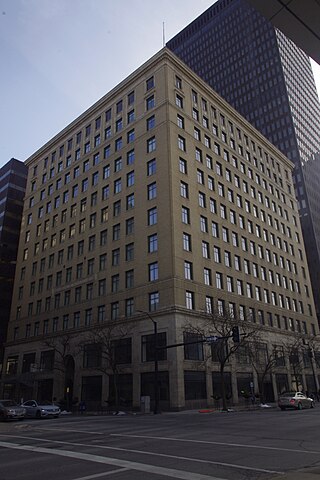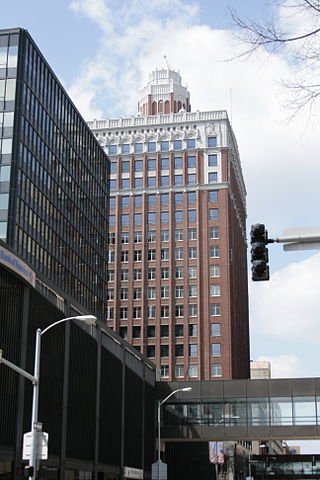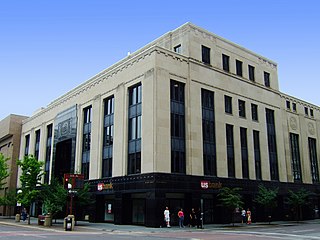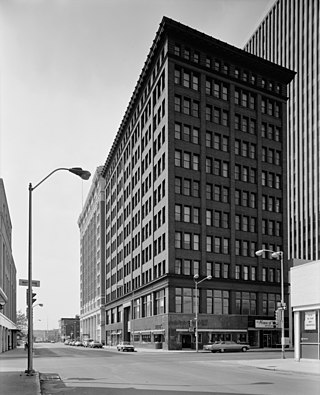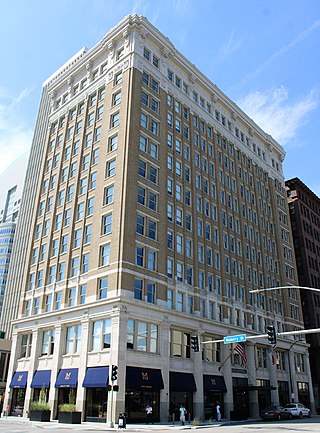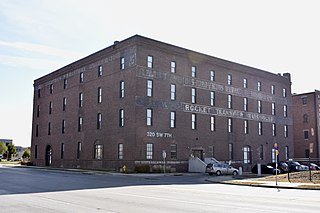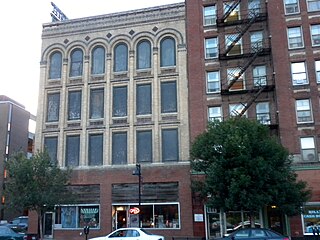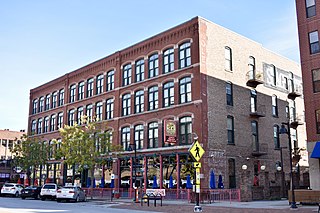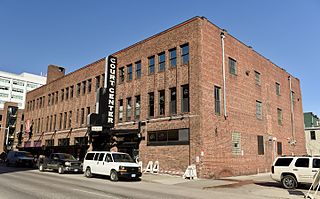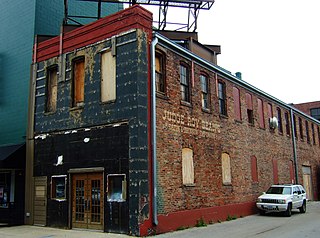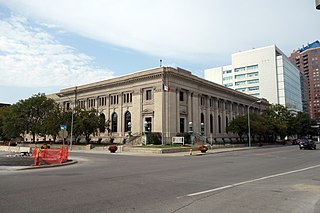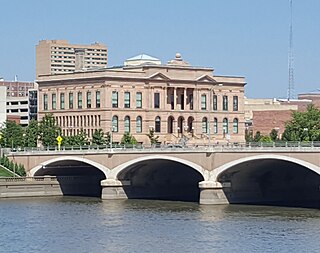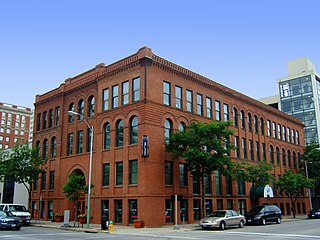Self-guided Sightseeing Tour #2 in Des Moines, United States
Legend
Tour Facts
9.5 km
0 m
Experience Des Moines in United States in a whole new way with our free self-guided sightseeing tour. This site not only offers you practical information and insider tips, but also a rich variety of activities and sights you shouldn't miss. Whether you love art and culture, want to explore historical sites or simply want to experience the vibrant atmosphere of a lively city - you'll find everything you need for your personal adventure here.
Individual Sights in Des MoinesSight 1: Crane Building
The Crane Building, also known as C.E. Erickson Co., in Des Moines, Iowa, United States. Crane Company was a plumbing and heating supplier and manufacturer that had this six-story manufacturing facility built in 1916. It was designed by the Des Moines architectural firm of Sawyer and Watrous. It is a utilitarian structure that is significant for its "thoughtful design" that utilizes elements of the Chicago School and a refined style. It was listed on the National Register of Historic Places in 2001. In 2013, the vacant building was renovated into 36 lofts targeted at artisans and costing 8 million dollars.
Wikipedia: Crane Building (Des Moines, Iowa) (EN), Heritage Website
Sight 2: Walnut Tire and Battery Co./Globe Publishing Company Building
The Walnut Tire and Battery Co. Globe Publishing Company Building is a historic building located on the west side of downtown Des Moines, Iowa, United States. The two-story brick commercial building features two mirror-image sections that were completed four years apart. The western section of the Late Gothic Revival structure was completed in 1924 and the eastern section in 1928. Between the two sections is an interior staircase and a lightwell. The building is located on Des Moines' historic Auto Row, and it housed automobile-related businesses. Walnut Tire and Battery Co. built the original section for their own use and to rent space to tenants. They built the second section to increase the tenant space. The building was listed on the National Register of Historic Places in 2017.
Wikipedia: Walnut Tire and Battery Co.-Globe Publishing Company Building (EN)
Sight 3: G.W. Jones Building
The G.W. Jones Building, also known as the Electric Farm Lighting Co. and the Laster Motor Company, is a historic building located in Des Moines, Iowa, United States. It is significant for its association with the rise of the automobile industry in the city. George W. Jones was a pioneering Des Moines auto dealer and Delco-Light generator distributor who occupied the building from 1920 to 1922. In this building he sold generators and appliances that were manufactured by General Motors, and they were sold by regional distributor-dealers in a similar fashion to automobiles. Jones continued to own the building until 1943 and he leased it to other automobile-related businesses. It is also significant for its association with the prominent Des Moines architectural firm that designed it, Proudfoot, Bird & Rawson. Completed in 1920, it was designed and built within the period of time the firm was at its most prolific (1910-1925). Local contractor A.H. Neumann built the two-story brick structure. It features a symmetrical facade, large square window openings, restrained Neoclassical details, and parapet walls. The building was listed on the National Register of Historic Places in 2016.
Sight 4: Apperson Iowa Motor Car Company Building
The Apperson Iowa Motor Car Company Building, also known as the Garage Building for Rawson Brothers, is a historic building located in Des Moines, Iowa, United States. It is significant for its association with the prominent Des Moines architectural firm that designed it, Proudfoot, Bird & Rawson. Completed in 1921, it was designed and built within the period of time the firm was at its most prolific (1910–1925). It is also significant for its association with the rise of the Automobile Industry in the city. Auto dealerships and distributorships leased the building from 1921 to 1951. Architect Harry D. Rawson and his brothers owned the building from 1921 to 1938. The two-story structure is located on a midblock lot in the midst of what was the automobile sales, service, and manufacturing district on the western edge of the downtown area. The first floor housed a showroom in the front with offices on a mezzanine. The back of the first floor and the second floor was used for assembling and servicing automobiles. The building was listed on the National Register of Historic Places in 2016.
Wikipedia: Apperson Iowa Motor Car Company Building (EN), Heritage Website
Sight 5: D.S. Chamberlain Building
The D.S. Chamberlain Building, also known as the L. W. Taylor Motor Company and Payne Motor Company Building, is a historic building located in Des Moines, Iowa, United States. The two-story brick structure was designed by the prominent Des Moines architectural firm of Proudfoot, Bird & Rawson. Completed in 1917, it features elongated Chicago-style windows on the upper floors and simple geometric details on the cornice level that reflect the Collegiate Gothic style. The building was built as a speculative venture by Davis S. Chamberlain, who was one of the founders of his family's drug manufacturing company. It is located in the city's "Motor Row" or "Auto Row" on the west side of downtown. In 1916 there were 111 motor related firms in Des Moines that was valued at $12 million in annual trade. Both the Taylor Motor Company and the Payne Motor Company were housed in the double storefront building for many years. Other car dealerships followed. The building was listed on the National Register of Historic Places in 2007.
Sight 6: John and Mary Pappajohn Sculpture Park
The John and Mary Pappajohn Sculpture Park is a 4.4-acre (1.8 ha) park within Western Gateway Park in Des Moines, Iowa. It opened in 2009 with 24 sculptures, with four more acquired later. The sculpture park is administered by the Des Moines Art Center and contains works by artists such as Louise Bourgeois, Jaume Plensa, Ai Weiwei, and Barry Flanagan. It is considered "one of the most significant collections of outdoor sculptures in the United States".
Sight 7: Iowa Ford Tractor Company Repair and Warehouse Building
The Iowa Ford Tractor Company Repair and Warehouse Building is a historic building located in Des Moines, Iowa, United States. The single-story, 15,000-square-foot (1,400 m2) building was built in 1949. It was used by the Iowa Ford Tractor Company as a tractor repair and storage facility. In 1977 the building was acquired by the H.B. Leiserowitz Company. They were mostly a photography supply company but they were also a general store and they sold wholesale candy, soda, chips, and cigarettes to small grocery stories and gas stations. It closed in 2017 after its owner died. Green Acre Development Company bought the building later the same year and has plans to convert it into offices. It was listed on the National Register of Historic Places in 2021.
Wikipedia: Iowa Ford Tractor Company Repair and Warehouse Building (EN)
Sight 8: Mack-International Motor Truck Corporation Building
The Mack-International Motor Truck Corporation Building is a historic building located in Des Moines, Iowa, United States. It was built by master builder and general contractor J.E. Lovejoy, who was also its original owner. Lovejoy and other tenants had offices on the second floor, while Mack Trucks occupied the ground floor. The front was used to showcase trucks and an industrial service space was in the back of the building. The two-story brick structure grew to take up a full quarter block after annexes were built in about 1931 and 1940. Located in Des Moines' historic Auto Row, the building was listed on the National Register of Historic Places in 2017.
Wikipedia: Mack-International Motor Truck Corporation Building (EN)
Sight 9: Herring Motor Car Company Building
The Herring Motor Car Company Building, now known as 10th Street Lofts, is a historic building located in downtown Des Moines, Iowa. The building is a six-story brick structure rising 90 feet (27 m) tall. It was designed by the Des Moines architectural firm of Proudfoot, Bird & Rawson in the Classical Revival style. Clyde L. Herring had the building built in 1912 and it was completed the following year. It was originally a four-story building with two more floors added 18 months after it was originally built. By 1915, the company was building 32 Ford automobiles a day, and had delivered “more automobiles than any other one automobile agency in the United States.” Along with the neighboring Standard Glass and Paint Company Building, today it is part of the same loft apartment complex. The National Biscuit Company Building on the other side of the building has likewise been converted into an apartment building. It was listed on the National Register of Historic Places in 2004.
Wikipedia: Herring Motor Car Company Building (EN), Heritage Website
Sight 10: Standard Glass and Paint Company Building
The Standard Glass and Paint Company Building, also known as 10th Street Lofts, is a historic building located in downtown Des Moines, Iowa, United States. Ashton and Ross Clemens, who were brothers, had the building built in 1913 to house their company, which was said to be the largest glass and paint business west of Chicago. Local contractor J.E. Lovejoy was responsible for its construction. It was one of several warehouse buildings on the southwest corner of the downtown area. Established by the Clemens brothers, Standard Glass and Paint Company was in existence from 1903 to 1979. It was Des Moines' leading wholesale and retail supplier of a variety of building and remodeling supplies. The company remained in this building until the mid-1920s when they moved to the Clemens Automobile Company Building, which was owned by the same family. After it sat empty until 1931 various wholesale companies occupied this building over the succeeding years. Along with the neighboring Herring Motor Car Company Building it has been converted into loft apartments. It was listed on the National Register of Historic Places in 2004.
Wikipedia: Standard Glass and Paint Company Building (EN), Heritage Website
Sight 11: National Biscuit Company Building
The National Biscuit Company Building, also known as National Biscuit Company Flats, is a historic building located in downtown Des Moines, Iowa, United States. The heavy timber and masonry building was built in 1906. Only half of the planned building was completed, and the north half of the property was later sold. It initially served as a production and distribution facility for the National Biscuit Company. Architect William F. Wilmouth, who designed the company's buildings is presumed to be the architect of this four-story Neoclassical building. Benson & Marxer served as the contractors. Des Moines was the third largest sales territory for the company. It was one of a few bakeries in the company that produced the Uneeda Biscuit, and it was one of three that produced a corn cracker in the mid-1920s.
Wikipedia: National Biscuit Company Building (Des Moines, Iowa) (EN), Heritage Website
Sight 12: Grocers Wholesale Company Building
The Grocers Wholesale Company Building, also known as the Sears and Roebuck Farm Store, is a historic building located in Des Moines, Iowa, United States. Completed in 1916, this was the first of four warehouses built and owned by Iowa's only and most successful statewide cooperative grocery warehouse. It is possible that it was the first statewide organization of this kind in the country. The cooperative allowed independent grocers to compete against chain stores and survive wholesale grocers' surcharges. They leased their first warehouse after they organized in 1912. Each successive time the cooperative built a new warehouse it was larger and technologically more advanced than the previous one. This particular cooperative grew to include parts of four states: Iowa, southern Minnesota, northern Missouri and eastern Nebraska. They built their second warehouse in 1930 and moved out of this facility. They continued to own this building until 1968, and they leased it out to other firms. The Sears Farm Equipment Store began to occupy the building in 1937 and continued here until 1959. The cooperative became the Associated Grocers of Iowa in the late 1950s, and it continued in existence until 1985. The building was listed on the National Register of Historic Places in 2008.
Wikipedia: Grocers Wholesale Company Building (EN), Heritage Website
Sight 13: Des Moines Social Club
The Des Moines Fire Department Headquarters' Fire Station No. 1 and Shop Building are historic buildings located in downtown Des Moines, Iowa, United States. Completed in 1937, the facility provided a unified campus for the fire department's administration, citywide dispatch, training, maintenance, as well as the increased need for fire protective services in the commercial and warehouse districts in which the complex is located. It was designed by the Des Moines architectural firm of Proudfoot, Rawson, Brooks and Borg, and built by local contractor F.B. Dickinson & Co. The project provided jobs for local residents during the Great Depression, and 45% of its funding was provided by the Public Works Administration (PWA). The City of Des Moines provided the rest of the funds. The radio tower, which shares the historic designation with the building, was used to dispatch fire personnel from 1958 to 1978. The buildings were used by the local fire department from 1937 to 2013. It was replaced by two different facilities. The old fire station and shop building was acquired by the Des Moines Social Club, a nonprofit arts organization.
Wikipedia: Des Moines Fire Department Headquarters (EN), Heritage Website
Sight 14: Clemens Automobile Company Building
The Clemens Automobile Company Building is a historic building located in downtown Des Moines, Iowa, United States. It was completed in 1916 as an "automotive department store" operated by the Clemens Automobile Company. They sold cars here that were produced by Willys-Overland Motors from 1916 to 1923. There was a claim that this was the largest building in the city that was devoted to automobiles. The first floor was used for the main sales room and offices, the second floor was used for used car sales and the service department, the fourth floor was used for a paint department, and the remaining three floors and the basement were used for storage. The Clemens family was involved in a variety of business enterprises and another one of their companies, the Standard Glass and Paint Company, was housed here from 1924 to 1979. The building was part of the Hotel Fort Des Moines until 2016, the two buildings were linked across the alley in 1985. The first and second floors housed Raccoon River Brewing Co. from May 1997 to March 2015. The building underwent a renovation in 2015 when it was converted to 44 apartments. At that time, the connection to the Hotel Fort Des Moines was sealed off. The first floor has been home to southern restaurant Bubba https://bubbadsm.com/ since July 2016.
Wikipedia: Clemens Automobile Company Building (EN), Heritage Website
Sight 15: Temple Theater
The Masonic Temple of Des Moines is a historic Beaux Arts style building located in Des Moines, Iowa. Constructed in 1913, it was listed on the National Register of Historic Places (NRHP) in 1997.
Wikipedia: Masonic Temple of Des Moines (EN), Heritage Website
Sight 16: Hawthorn Hill Apartments
The Methodist Deaconess Institute—Esther Hall, also known as Hawthorn Hill Apartments, is a historic building located in Des Moines, Iowa, United States. This building has been known by a variety of titles. They include the Bible Training School, Women's Foreign Missionary Society; Women's Home Missionary Society-Bible Training School; Iowa National Esther Hall & Bidwell Deaconess Home; Hawthorn Hill; and Chestnut Hill. The Women's Home Missionary Society of the Methodist Episcopal Church established a Des Moines affiliate in 1896. Part of their responsibilities was to oversee the work of deaconesses of the church. At about the same time a Bible training school was established at Iowa Methodist Hospital's School of Nursing.
Wikipedia: Methodist Deaconess Institute—Esther Hall (EN), Heritage Website
Sight 17: Register and Tribune Building
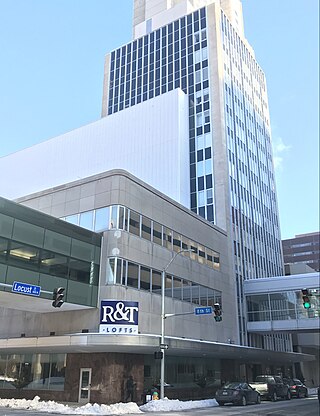
The Register and Tribune Building is a historic commercial building at 715 Locust Street in Des Moines, Iowa. Built in 1918, it served as home to The Des Moines Register, one of Iowa's leading newspapers, until about 2000, when the presses were moved to another building, and 2013, when the Register's owner, the Gannett Corporation, moved out in 2013. It was designed by one of Iowa's leading architectural firms, Proudfoot, Bird and Rawson, with later additions by equally prominent firms.
Wikipedia: Register and Tribune Building (EN), Heritage Website
Sight 18: Hubbell Tower Condominiums
The Hubbell Building is a historic building located in downtown Des Moines, Iowa, United States. It was listed on the National Register of Historic Places in 2004. It has been featured on the Discovery Channel show Dirty Jobs.
Wikipedia: Hubbell Building (Des Moines, Iowa) (EN), Heritage Website
Sight 19: Edna M. Griffin Building
The Flynn–Griffin Building, also known as the Flynn Block, Peoples' Savings Bank Building, and the Edna M. Griffin Building, is a historic building located in Des Moines, Iowa, United States. It was listed on the National Register of Historic Places in 2016.
Sight 20: Des Moines Building
The Des Moines Building is a historic building located in downtown Des Moines, Iowa, United States built in 1930 and based on the designs of the Des Moines architectural firm of Proudfoot, Rawson, Souers & Thomas. It is a combination of the Art deco and Art Moderne styles. The 14-story structure rises to a height of 190 feet (58 m). The former office building was abandoned and in May 2011 the city of Des Moines declared it a public nuisance so as to acquire it to be redeveloped. In November of the same year they sold the building for $150,000 to Des Moines Apartments, LP who developed it into 146 loft apartments. It was listed on the National Register of Historic Places in 2013. The basement has a fitness center, laundry room, storage, bicycle storage, and a community room. The rooftop is accessible via the 14th floor and has a great 360 degree view of Des Moines. The building is also connected to the city's extensive skywalk system.
Sight 21: Saint Ambrose Cathedral
St. Ambrose Cathedral is a historic building located in downtown Des Moines, Iowa, United States. It serves as a parish church and as the seat of the Diocese of Des Moines in the Catholic Church. The cathedral, along with the adjoining rectory, was listed on the National Register of Historic Places in 1979.
Wikipedia: St. Ambrose Cathedral (Des Moines, Iowa) (EN), Website, Heritage Website
Sight 22: Catholic Pastoral Center
The Home Federal Savings and Loan Association of Des Moines Building, also known as American Federal Savings and the Catholic Pastoral Center, is a historic building located in downtown Des Moines, Iowa, United States. Completed in 1962, it is considered to be "one of the most well-known examples of mid-century modern architecture in Des Moines."
Wikipedia: Home Federal Savings and Loan Association of Des Moines Building (EN)
Sight 23: Liberty Building
The Liberty Building is a historic building located in downtown Des Moines, Iowa, United States. It has been a downtown landmark since 1923. The Liberty Building is located at the SW corner of 6th Avenue and Grand Avenue in the heart of downtown Des Moines. The building was originally home to Bankers Life Insurance & WHO (AM) Radio. Designed by the prominent Des Moines architectural firm of Proudfoot, Bird & Rawson, the 12-story building rises to a height of 174 feet (53 m).
Wikipedia: Liberty Building (Des Moines, Iowa) (EN), Heritage Website
Sight 24: Equitable Building
The Equitable Building is a high-rise located in Des Moines, Iowa. It is named after the insurance company Equitable of Iowa, which originally owned the building, and is located along Locust Street in the downtown area of the city. The 19-story Equitable Building, at 604 Locust St. in Des Moines, was completed in 1924, and standing at 318 ft (97m), for 49 years was the tallest building in Iowa. It remained the tallest building in Iowa until the completion of Financial Center in 1973. The Equitable Building is now the eighth tallest building in Iowa.
Wikipedia: Equitable Building (Des Moines) (EN), Heritage Website
Sight 25: U.S. Bank
The Iowa-Des Moines National Bank Building, also known as the Valley National Bank Building and U.S. Bank, is a historic building located in downtown Des Moines, Iowa, United States. Designed by the prominent Des Moines architectural firm of Proudfoot, Rawson, Souers & Thomas, it was designed to be a 21- or 22-story building. It is one of the few downtown commercial buildings built in the Art Deco style. It is also thought to be one of the first bank buildings to put the banking room on the second floor while placing retail space on the first floor. Given its location in an area dominated by retail this made sense. This location had a bank on it since 1882 when the Des Moines National Bank built here. The present building was the result when Des Moines National Bank merged with Iowa National Bank and Des Moines Savings Bank and Trust Company in 1929. The original design for the building was a five-story base and a set-back rental office tower on top of it. The base was begun in 1931 and completed a year later. The building is composed of black polished granite on the first floor and the upper floors are Bedford stone. There is a recessed entrance in the center bay of the main facade. The fifth floor was meant to be the base of the office tower that was never built.
Wikipedia: Iowa-Des Moines National Bank Building (EN), Heritage Website
Sight 26: Fleming Building
The Fleming Building is a historic building located in downtown Des Moines, Iowa, United States. It was listed on the National Register of Historic Places in 2002.
Sight 27: Midland Financial Building
The Hippee Building, also known as the Southern Surety Building, the Savings and Loan Building, and the Midland Building, is a historic building located in downtown Des Moines, Iowa, United States. It was completed in 1913 by George B. Hippee whose father, George M. Hippee, was one of the first merchants in Des Moines. George B. developed the first interurban railway in the city and it connected Des Moines to other communities in central Iowa. The 172-foot (52 m), 12-story structure was designed by the Des Moines architectural firm of Sawyer and Watrous in the Early Commercial style. At the time of it completion, the building was Iowa's tallest skyscraper. It was used as an office building until the Aparium Hotel Group of Chicago acquired it in 2017 and began converting the building into a 138-room hotel. It was listed on the National Register of Historic Places in 2018.
Sight 28: Polk County Courthouse
The Polk County Courthouse located in Des Moines, Iowa, United States, was built in 1906. It was listed on the National Register of Historic Places in 1979 as a part of the County Courthouses in Iowa Thematic Resource. The courthouse is the third building the county has used for court functions and county administration.
Wikipedia: Polk County Courthouse (Iowa) (EN), Heritage Website
Sight 29: Rocket Transfer Lofts
The Hawkeye Transfer Company Warehouse, also known as the Rocket Transfer Building, is a historic building located in downtown Des Moines, Iowa, United States. The building was built by Frederick Hubbell who founded F.M. Hubbell and Son, which became Hubbell Realty Co. The company has retained ownership of the building since it was built. Plans were approved in 2009 to convert the building, as well as the Schmitt and Henry Manufacturing Company complex, into loft apartments. It was listed on the National Register of Historic Places in 2010.
Wikipedia: Hawkeye Transfer Company Warehouse (EN), Heritage Website
Sight 30: Hubbell Warehouse
The Hubbell Warehouse is an historic building located in downtown Des Moines, Iowa, United States. It was listed on the National Register of Historic Places in 2010.
Sight 31: Harbach Lofts
The L. Harbach and Sons Furniture Warehouse and Factory Complex, also known as the Way-Helms Co. & Red Cross Mattress, L. Ginsberg & Sons wholesale furniture warehouse, and the A.A. Schneiderhahn electronic appliances warehouse, is a historic building located in Des Moines, Iowa, United States. This is actually two adjacent buildings completed in 1906. Their significance is their successive ownership by three prominent furniture retailers/wholesalers. L. Harbach & Sons Co. was one of Iowa's largest furniture wholesalers, and they manufactured furniture in Des Moines for more than seventy years. The company was established in 1856 by Louis Harbach, Sr. Louis had immigrated from Germany in 1850 at the age of 12. A catalog of their furniture is available at the National Museum of America. L. Harbach & Sons occupied this complex from 1906 to 1928. One of the buildings was their factory and the other was their warehouse. The Harbach family sold the business around 1920 to the Davidson family, who continued to use the Harbach name until through 1928, and continued to own the building until 1952. They leased the buildings to Way-Helms Co. & Red Cross Mattress for a short time, and then beginning in 1930, to the Ginsberg family. Both the Davidsons and the Ginsbergs owned local furniture stores. The Ginsbergs acquired the buildings from the Davisons and they owned them until 1985. They altered the building as trucks replaced trains as the main mode of transportation for furniture warehousing and distribution. The buildings were listed on the National Register of Historic Places in 2015.
Wikipedia: L. Harbach and Sons Furniture Warehouse and Factory Complex (EN), Heritage Website
Sight 32: Science Center of Iowa
The Science Center of Iowa is a science museum located in Des Moines, Iowa.
Sight 33: Rumely Lofts
The Rumely–Des Moines Drug Company Building at 110 SW. Fourth St. in Des Moines, Iowa is a large brick warehouse block building. It is a work of architects Hallett & Rawson. It has also been known as the Rumely Bldg, as the Federal Machine Corp Bldg, and as the Security File Warehouse Building. It was listed on the National Register of Historic Places in 1989.
Wikipedia: Rumely–Des Moines Drug Company Building (EN), Heritage Website
Sight 34: Earle & LeBosquet Block
The Earle & LeBosquet Block, also known as the Redhead & Wellslager Block, is a historic building located in Des Moines, Iowa, United States. Completed in 1896, the building is a fine example of the work of Des Moines architect Charles E. Eastman. It shows Eastman's ability to use Neoclassical forms and integrate the more modern Chicago Commercial style. It is also an early use of terra cotta for architectural detailing and buff-colored brick for the main facade in Des Moines, which became widespread in the city in the following decades. The main floor housed two commercial spaces and the upper floors were used for warehouse space. The four-story structure was built by local contractor Gerrit Van Ginkel, and it was owned by attorneys Ira M. Earle and Peter S. LeBosquet. It replaced a three-story brick building that was built at this location in 1876. The building was listed on the National Register of Historic Places in 2009.
Sight 35: Youngerman Block
Youngerman Block is a three-story commercial building in downtown Des Moines, Iowa, incorporating Italianate architecture, with later alterations that introduced Art Deco detailing. Built in 1876, the Youngerman Block was designed by architect William Foster (1842-1909) for Conrad Youngerman.
Sight 36: Des Moines Saddlery Company Building
The Des Moines Saddlery Company Building is a historic building located in downtown Des Moines, Iowa, United States. It was built in 1881 by J. Rubelman of Muscatine, Iowa. He choose to move his operation to Des Moines because of its location on two rivers and the 13 railroads that served the city. It was one of four saddlery firms in a two block area. Rubelman's company made saddles, harnesses and leather works for 20 years. In the years since it has housed a shoe maker, rubber company, stove manufacturer, glove company, the Krispy Kone Company and the Kaplan Hat Company. The later was also the name of the restaurant that was located on the first floor.
Wikipedia: Des Moines Saddlery Company Building (EN), Heritage Website
Sight 37: Seth Richards Commercial Block
The Seth Richards Commercial Block, also known as the Lederer-Strauss Building, is a historic building located in downtown Des Moines, Iowa, United States. Its construction represents the transition of Court Avenue from a retail center to the city's wholesale district.
Wikipedia: Seth Richards Commercial Block (EN), Heritage Website
Sight 38: Court Center
The Taft–West Warehouse, also known as the C.C. Taft Company Building, Plumb Supply Company, Ben's Furniture Warehouse, and Nacho Mamma's, is a historic building located in Des Moines, Iowa, United States. Completed in 1923, this three-story brick structure was built during a transitional period between the dominance of railroads the emergence of trucks servicing warehouses. It was designed by local architectural firm of Vorse, Kraetsch, & Kraetsch. It features cleans lines of the Commercial style as opposed to the fussiness of late Victorian styling that was dominant in a great deal of the city's commercial architecture. The building was also located in the Court Avenue wholesale district, and now it is only one of only five or six that remain extant. The building was constructed for the C.C. Taft Company. This firm and the O.B. West Company that succeeded it in this building, dealt in wholesale fruits, vegetables, candy and tobacco. The building was listed on the National Register of Historic Places in 2006.
Sight 39: Boyt Company Building
The Boyt Company Building, also known as the Gilchrist Building, is a historic building located in Des Moines, Iowa, United States. The significance of this two-story brick structure is its association with the Boyt Company. Boyt manufactured leather goods in this building from 1904, when it was built, until 1908. They moved to a now nonextant building to the west at that time. From 1943 to 1945 Boyt was a contractor with the United States Armed Forces, and they leased this building as a depot for shipping supplies. They supplied leather and canvas goods to the Marine Corps, the Navy Department, Signal Corps, Rock Island Arsenal and Ordnance Department, the Army Air Force, and the Treasury Department, among others.
Sight 40: Warfield, Pratt and Howell Company Warehouse
The Warfield, Pratt and Howell Company Warehouse is a historic building located in downtown Des Moines, Iowa, United States. The building was built by wholesale grocer Warfield, Pratt and Howell Company. Wilson R. Warfield and John W. Howell moved their business to Des Moines in 1860 and moved to this location in 1884. William J. Pratt joined the partnership in 1897. The structure is a six-story commercial and office building that rises 93 feet (28 m) above the ground. The building was designed by Architect, Frank Crocker, and it is considered a good example of warehouse construction from the turn of the 20th century. It was completed in 1901 with an addition completed in 1909. It features load bearing brick piers, bearing walls, and wood column and girder technology on the interior. Other wholesale firms were housed in the building after 1935. It was part of a redeveloped district in the 1980s. The building was listed on the National Register of Historic Places in 1985.
Wikipedia: Warfield, Pratt and Howell Company Warehouse (EN), Heritage Website
Sight 41: Court Avenue Bridge
The Court Avenue Bridge is a historic structure located in downtown Des Moines, Iowa, United States. It became a contributing property in the Civic Center Historic District in 1988, and was individually listed on the National Register of Historic Places on May 15, 1998 as a part of the Highway Bridges of Iowa MPS.
Sight 42: Polk County Adminstration Building
The United States Post Office is a historic building located in Des Moines, Iowa, United States. It was individually listed on the National Register of Historic Places in 1974. It became a contributing property of the Civic Center Historic District when it was established in 1988. It now houses administrative offices for Polk County.
Wikipedia: United States Post Office (Des Moines, Iowa) (EN), Heritage Website
Sight 43: World Food Prize Hall of Laureates
The Old Downtown Des Moines Library is a historic building in downtown Des Moines, Iowa, United States that was built in 1903. It was individually listed on the National Register of Historic Places in 1977, and became a contributing property in the Civic Center Historic District in 1988. The building ceased to be a library in 2006 and now houses the Norman E. Borlaug | World Food Prize Hall of Laureates for the World Food Prize.
Wikipedia: Old Downtown Des Moines Library (EN), Website, Heritage Website
Sight 44: Civic Center of Greater Des Moines
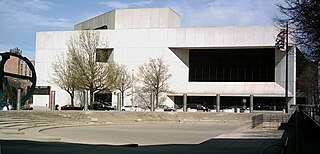
The Des Moines Civic Center is a 2,744-seat performing arts center belonging to Des Moines Performing Arts located in Des Moines, Iowa. It has been Iowa's largest theater since it opened on June 10, 1979, and is used for concerts, Broadway shows, ballets, and other special events.
Sight 45: Homestead Building
The Homestead Building, also known as the Martin Hotel, is a historic building located in Des Moines, Iowa, United States. Designed by the Des Moines architectural firm of Smith & Gage, it was built in two stages. The eastern one-third was completed in 1893 and the western two-thirds was completed in 1905. It is one of a few late nineteenth-century commercial/industrial buildings that remain in the downtown area. The building was built for James M. Pierce for his publishing operation, which included the Iowa Homestead, a pioneer publication of modern agricultural journalism. Prior to Pierce, the Iowa Homestead publisher was Henry Wallace, the father of Agriculture Secretary Henry C. Wallace, and grandfather of U.S. Vice President Henry A. Wallace. "Through the efforts of Pierce and Wallace the Iowa Homestead became known for its promotion of the rotation of crops, the use of better seed, the value of more and better livestock, the importance of an attractive home and a good home life, the value of farmers banding together to protect common interests, and the care of the soil and conservation of its resources."
Sight 46: Des Moines City Hall

The Des Moines City Hall is a government building in Des Moines, Iowa, built in 1909 and 1910. It was individually listed on the National Register of Historic Places on November 10, 1977 as the Municipal Building, and became a contributing property in the Civic Center Historic District in 1988. The building serves as the seat for the government of the city of Des Moines. Beginning April 7, 2016, City Hall offices were temporarily relocated while the building underwent renovation. The construction was necessary to install modern heating, cooling, and sprinkler systems while preserving the historic character of the building. The project was expected to take 18–24 months. During that time, City Hall was closed to the public, and City offices moved to other nearby locations. Between February 26, 2018 and April 9, 2018, city offices moved back to City Hall.
Share
How likely are you to recommend us?
Disclaimer Please be aware of your surroundings and do not enter private property. We are not liable for any damages that occur during the tours.
GPX-Download For navigation apps and GPS devices you can download the tour as a GPX file.

